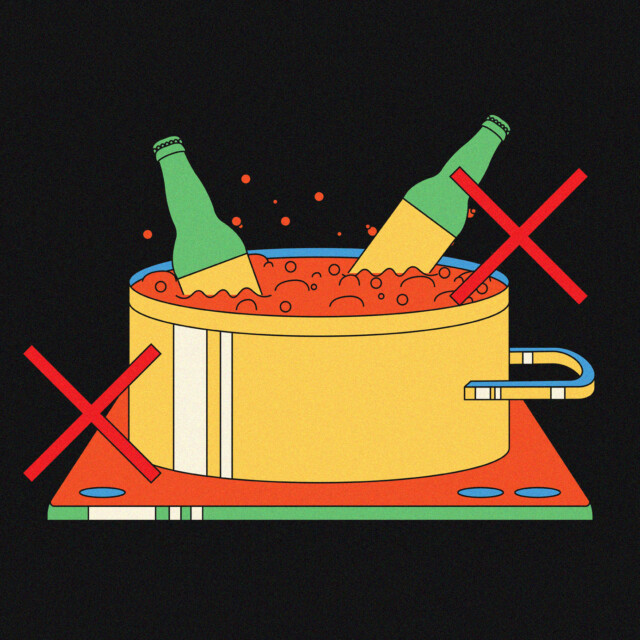Southern Tier Brewing Co.’s Nu Haze IPA is missing something every other beer has — something that’s always been considered essential to beer. It’s not a special ingredient. It’s not flavor (it has plenty). Instead, Nu Haze is made by skipping a step of the brewing process, and it happens to be the most energy-intensive one. Could the beer be a template for a more energy-efficient brew day?
Beer is one of the oldest fermented beverages on Earth. When beer production was formalized many centuries ago, it required the same basic steps brewers follow today: Integrate grains and water, heat them until they make a thick oatmeal-like mixture, remove the grains from that mixture and boil the remaining liquid, let it sit for a while (what we now recognize as fermentation), and a few days later, its ready to drink. This process was developed and perfected over many centuries, long before matters of sustainability were ever considered. Now that conversations about carbon emissions are central to the food and beverage industries, it may be time to rethink the traditional brewing process.
“Boiling wort is the most energy-intensive part of the brewing process, strictly speaking,” says Matt Dunn, vice president of operations at Southern Tier. (This doesn’t consider the energy used to grow and process brewing ingredients.) The boil uses so much energy because the wort (the liquid containing extracted grain sugars that eventually becomes beer) needs to be held at a rolling boil for roughly an hour; sometimes longer. Consider how long it takes your stovetop to heat a little pasta water to a boil — then think of doing that same thing at 1,000 times the scale. It requires some serious power. In fact, the CO2 emitted from boiling one 10-barrel batch of beer at a commercial scale is roughly equivalent to taking a four-hour road trip in a standard passenger vehicle.
Boil, What is It Good For?
The boil process requires massive amounts of energy. So, why are brewers still using it? In the traditional process, the boil serves several purposes. Two of the most important are sterilizing the wort and converting hop acids into the bitter flavors that were once signature to beer.
Now that the haze craze has dominated the industry for several years, creating those bitter hop compounds is no longer essential. In fact, for a brewer looking to make the juiciest beer possible, it’s a negative result of boiling.
“Skipping the boil leaves more protein in the beer, which gives it this chewier consistency,” says Sarah Flora of the homebrewing YouTube channel Flora Brewing. When it comes to beer styles that fit this fuller mouthfeel, she says, “New England IPA comes to mind because you already add adjuncts to give these beers more body.”
Homebrewers like Sarah can experiment with the full mouthfeel and soft tropical hop character in beers that skip the boil because these creations don’t travel far from the brewhouse they were made in and don’t sit for long on shelves. Since the beer isn’t fully sterilized in the boil, there may be microbes that could grow in the beer and cause off flavors or other maleffects.
However, the team at Southern Tier wanted to create an IPA that had the characteristics of an unboiled beer and that could be distributed to store shelves in more than 30 states. According to Dunn, the target attributes were “improving haze stability, body, mouthfeel, and foam stability.” They needed to tackle the issue of combating microbes without fully sterilizing the wort by boiling it.
It took extensive experimenting to find the right treatment that maintains the silky mouthfeel of Nu Haze, while ensuring all problematic microbes were eliminated. To achieve this, brewers heat Nu Haze wort at 180 degrees Fahrenheit for 15 minutes, effectively pasteurizing the wort. The result is a brew day that saves on energy and can be completed in about a quarter of the time it takes for a standard boil.
How Much Energy Does Skipping the Boil Save, Really?
The boil accounts for around 50 percent of the total heat required to make a beer. Karl Ockert, editor of the Master Brewers Association of the Americas “Practical Handbook for the Specialty Brewer,” estimates that the boil accounts for about 139 cubic feet of natural gas per hectoliter (~26 gallons) of beer brewed. For context, the average American household uses about 175 cubic feet of natural gas on a daily basis.
As for Southern Tier, “About 4,000 cubic feet of natural gas would be a very rough estimate of gas saved by not fully boiling one batch of our wort,” says Dunn. The energy conserved from brewing one batch of Nu Haze this way could cover a household’s natural gas usage for more than three weeks.
Even with such sizable energy savings, Dunn reiterates, “While no-boil beers do save some natural gas, they create some well-understood risks and aren’t appropriate for all styles of beer.” The good news is the hazy (or New England) IPA is a great candidate for this sustainable brewing process. The Nu Haze label calls it a Hazy Smooth IPA, and the beer has the soft melon and tropical fruit notes that dominate today’s craft beer landscape.
Skipping the boil isn’t a one-size-fits-all solution for energy-efficient brewing. But, even macrobrewers see the benefit in cutting down on this energy-sucking step of the brewing process. Nu Haze is proof that it’s possible to successfully produce a no-boil beer at a commercial scale and benefit from both the energy savings and unique texture and flavors imparted by this production method. The ever-popular hazy IPA category may continue to thrive in future years, as it has the potential to become the most energy-conscious style on the craft beer market.
This story is a part of VP Pro, our free platform and newsletter for drinks industry professionals, covering wine, beer, liquor, and beyond. Sign up for VP Pro now!
